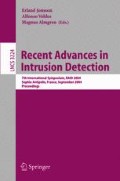Abstract
Intruders on the Internet often prefer to launch network intrusions indirectly, i.e., using a chain of hosts on the Internet as relay machines using protocols such as Telnet or SSH. This type of attack is called a stepping-stone attack. In this paper, we propose and analyze algorithms for stepping-stone detection using ideas from Computational Learning Theory and the analysis of random walks. Our results are the first to achieve provable (polynomial) upper bounds on the number of packets needed to confidently detect and identify encrypted stepping-stone streams with proven guarantees on the probability of falsely accusing non-attacking pairs. Moreover, our methods and analysis rely on mild assumptions, especially in comparison to previous work. We also examine the consequences when the attacker inserts chaff into the stepping-stone traffic, and give bounds on the amount of chaff that an attacker would have to send to evade detection. Our results are based on a new approach which can detect correlation of streams at a fine-grained level. Our approach may also apply to more generalized traffic analysis domains, such as anonymous communication.
Access this chapter
Tax calculation will be finalised at checkout
Purchases are for personal use only
Preview
Unable to display preview. Download preview PDF.
References
Staniford-Chen, S., Heberlein, L.T.: Holding intruders accountable on the internet. In: Proceedings of the 1995 IEEE Symposium on Security and Privacy, Oakland, CA, pp. 39–49 (1995)
Zhang, Y., Paxson, V.: Detecting stepping stones. In: Proceedings of the 9th USENIX Security Symposium, August 2000, pp. 171–184 (2000)
Yoda, K., Etoh, H.: Finding a connection chain for tracing intruders. In: Cuppens, F., Deswarte, Y., Gollmann, D., Waidner, M. (eds.) ESORICS 2000. LNCS, vol. 1895, Springer, Heidelberg (2000)
Donoho, D., Flesia, A.G., Shankar, U., Paxson, V., Coit, J., Staniford, S.: Multiscale stepping-stone detection: Detecting pairs of jittered interactive streams by exploiting maximum tolerable delay. In: Wespi, A., Vigna, G., Deri, L. (eds.) RAID 2002. LNCS, vol. 2516, p. 17. Springer, Heidelberg (2002)
Wang, X., Reeves, D.: Robust correlation of encrypted attack traffic through stepping stones by manipulation of inter-packet delays. In: Proceedings of the 2003 ACM Conference on Computer and Communications Security (CCS 2003), pp. 20–29. ACM Press, New York (2003)
Kearns, M., Vazirani, U.: An Introduction to Computational Learning Theory. MIT Press, Cambridge (1994)
Valiant, L.: A theory of the learnable. Communications of the ACM 27, 1134–1142 (1984)
Blumer, A., Ehrenfeucht, A., Haussler, D., Warmuth, M.K.: Occam’s razor. Information Processing Letters 24, 377–380 (1987)
Stoll, C.: The Cuckoo’s Egg: Tracking a Spy through the Maze of Computer Espionage. Pocket Books (2000)
Wang, X., Reeves, D., Wu, S., Yuill, J.: Sleepy watermark tracing: An active network-based intrusion response framework. In: Proceedings of the 16th International Information Security Conference (IFIP/Sec 2001), pp. 369–384 (2001)
Wang, X., Reeves, D., Wu, S.: Inter-packet delay-based correlation for tracing encrypted connections through stepping stones. In: Gollmann, D., Karjoth, G., Waidner, M. (eds.) ESORICS 2002. LNCS, vol. 2502, pp. 244–263. Springer, Heidelberg (2002)
Wang, X.: The loop fallacy and serialization in tracing intrusion connections through stepping stones. In: Proceedings of the 2004 ACM Symposium on Applied Computing, Nicosia, Cyprus, pp. 404–411. ACM Press, New York (2004)
Paxson, V., Floyd, S.: Wide-area traffic: The failure of poisson modeling. IEEE/ACM Transactions on Networking 3, 226–244 (1995)
Author information
Authors and Affiliations
Editor information
Editors and Affiliations
Rights and permissions
Copyright information
© 2004 Springer-Verlag Berlin Heidelberg
About this paper
Cite this paper
Blum, A., Song, D., Venkataraman, S. (2004). Detection of Interactive Stepping Stones: Algorithms and Confidence Bounds. In: Jonsson, E., Valdes, A., Almgren, M. (eds) Recent Advances in Intrusion Detection. RAID 2004. Lecture Notes in Computer Science, vol 3224. Springer, Berlin, Heidelberg. https://doi.org/10.1007/978-3-540-30143-1_14
Download citation
DOI: https://doi.org/10.1007/978-3-540-30143-1_14
Publisher Name: Springer, Berlin, Heidelberg
Print ISBN: 978-3-540-23123-3
Online ISBN: 978-3-540-30143-1
eBook Packages: Springer Book Archive

